Best Fleet Management Software
We’ve analyzed the top fleet management software on the market for industries like construction, logistics, and the public sector. These platforms can help you maximize vehicle lifespans and optimize routes.

- Collects telematics data
- Compatible apps for iOS and Android
- Predictive ETAs
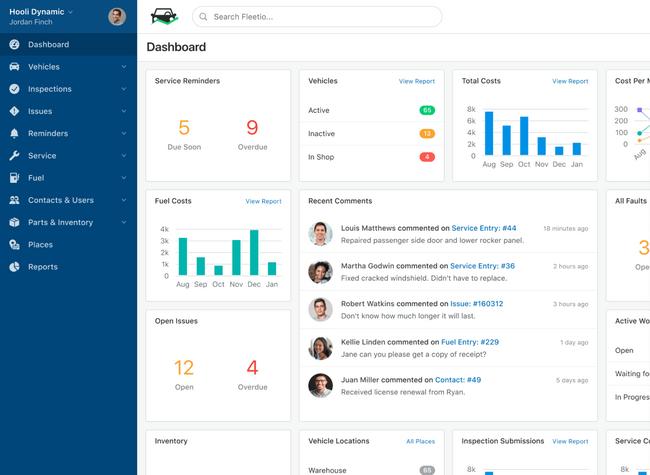
- Collects telematics data
- Low starting cost per month
- Cloud-based platform centralizes fleet data
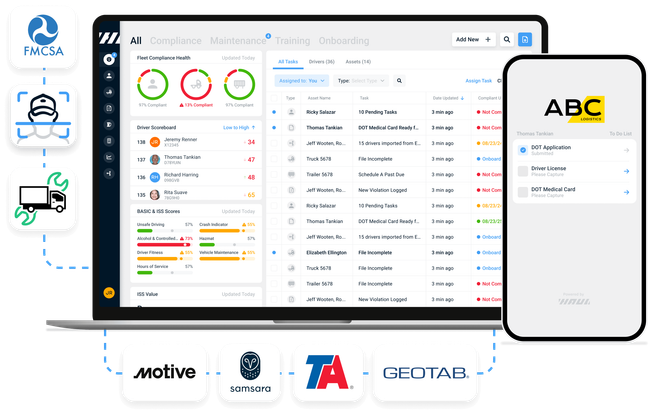
- Can handle complex toll reconciliation, auditing and back office integration.
- Have over 880+ sites in North America for bypass stations.
- Integrates easily with the major telematics (ELD) companies
Fleet management software tracks company vehicles and optimizes maintenance, routing, and fuel usage. We used our review methodology to rank our top picks based on features like route optimization and GPS tracking.
- Samsara: Best Overall
- Fleetio: Best for Construction
- Fleetworthy: Best for Safety and Compliance
- GeoTab: Best for Public Sector
- AUTOsist: Best for Utilities
- Omnitracs: Best for Long-Haul Trucking
- Onfleet: Best for Retail
- Azuga: Best for Service Industries
- TransPlus: Best for International Logistics
Samsara - Best Overall
Samsara includes strong GPS tracking capabilities and advanced dashcam technology. The technology uses artificial intelligence to detect and record driving events. Additionally, Samsara has geofencing tools to monitor and enforce compliance with regulations, making it a strong pick for transportation and logistics companies.
Samsara’s one-update-a-second refresh rate ensures fleet managers can access nearly instantaneous data about their vehicles’ locations and conditions. Their dual-facing dashcams provide insights into driver behavior and enhance safety with features like night vision and driver alert functions. To cap it off, Samsara’s manager dashboard and driver app streamline communication and task management.
Samsara does not publicly list starting costs, but it’s priced per vehicle per month, which can quickly add up depending on the size of your fleet. Additionally, it requires a three-year minimum contract.
Fleetio - Best for Construction
Fleetio’s expense tracking software helps construction companies get a real time view of each vehicle’s total cost of ownership. The dashboard has an interactive chart that shows a breakdown of your vehicle’s expenses over a specific period. This can include fuel, service, and miscellaneous costs, giving you a better understanding of the asset’s profitability.
Additionally, you can create custom expense reports to help you manage lifecycles. In the operating costs summary, view the total cost of a truck or piece of heavy machinery on one screen. Easily filter the data by different groups, vehicle types, or time frames to compare assets. Identify problematic machines by evaluating trends over time on easy-to-read pie and bar graphs. This allows you to adjust usage to determine ROI and make informed decisions to replace problematic equipment.
Fleetio is best for those managing a fleet of at least five vehicles. Like Samsara, it’s priced per vehicle, which can quickly add up for larger fleets. The lowest-tier plan, Essential, starts at $4/vehicle/month, billed annually. The plan limits you to 100 vehicles, so if you exceed this limit you’ll need to upgrade to the $7/vehicle/month Professional plan.
Fleetworthy - Best for Safety and Compliance
Fleetworthy’s licensing and permitting module helps you maintain valid credentials across different jurisdictions. That way, you can prevent lapses that could lead to audits or ground your vehicles. FleetWorthy’s team provides a compliance roadmap tailored to your company’s actual footprint by assessing your operating regions, travel routes, and vehicle types. You can ensure proper licensing for every vehicle, permitted according to IFTA and IRP standards.
Once Fleetworthy sets this baseline, it pivots to ongoing process management. Fleetworthy’s specialists continuously monitor changes in state and federal regulations, managing any updates or renewals to prevent downtime. It handles initial permit applications, renewals, and ongoing coordination with agencies. In other words, they free up your internal staff by providing an expert-led process that stays current on compliance requirements.
Each update, communication, and document is logged in the record retention system. This provides you with immediate access during IFTA or DOT reviews, ensuring you never fall prey to fines or penalties due to disorganized paperwork. This keeps each vehicle’s compliance history fully traceable and transparent, allowing you to easily export it for audit preparation. Plus, the module’s reporting tools transform compliance data into operational insights. For example, you can examine asset utilization to identify underutilized or overburdened vehicles, which will help you detect regulatory risks such as missed inspection intervals or preventive maintenance.
Fleetworthy’s compliance solutions are best suited for complex compliance needs across multiple vehicles and states. It’s probably more system than you need if you’re a fleet with just one or two trucks. The platform is priced per unit, though exact rates aren’t published.
GeoTab - Best for Public Sector
GeoTab is a solid option for the public sector because of its compliance and safety features. It offers an FMCSA-compliant ELD (Electronic Logging Device) that automatically records driving time and engine data for regulatory adherence. This means all government employees, whether that’s police, utility, or transport fleets, don’t exceed hours of service limits. This lets you eliminate manually tracking driving time and quickly identify unauthorized use of vehicles.
Additionally, GeoTab includes electronic DVIR inspections via the mobile app. You can create custom inspection checklists based on your fleet’s vehicles and compliance requirements. If one fails an inspection, you’re alerted instantly so you can schedule maintenance as soon as possible. This reduces downtime and keeps drivers safe.
The system automatically generates ELD-compliant reports to track driver hours, vehicle issues, and work limits. Each is filed in the system with clear audit reports that show complete driver history, which gives you more transparency. Additionally, Geotab earned certifications like FIPS 140-2, FedRAMP, and ISO 27001 to meet stringent government security and data protection standards.
GeoTab does not display any pricing information on its website. Instead of selling directly, it utilizes a network of resellers who enhance the product’s value by offering additional services such as sales, support, consulting, and project management. That said, it can be a hindrance if you end up with a poor reseller—just be sure to thoroughly vet your options before choosing.
AUTOsist - Best for Utilities
AUTOsist is a solid option for the utilities sector because it can manage diverse assets, from vehicles to generators and heavy machinery. We demoed the system for ourselves and found it easy to track maintenance, inspections, fuel, and other vehicle records. Its customizable spreadsheets and digital forms allow operators to tailor fleet management and maintenance records to their needs.
Suited for small to medium-sized businesses that manage fleets of 50-100 units, AUTOsist generates driver behavior assessments through GPS tracking and scorecards. It offers dual-facing in-cab HD safety cameras for enhanced accountability. Additionally, the system is web-based with a mobile app for iOS and Android so operators can manage fleets remotely. They can easily set service reminders, upload fuel receipts, and assign multiple drivers to vehicles on one platform.
AUTOsist’s lowest-tier plan, the Maintenance Package, starts at $5/vehicle/month, billed annually. While AUTOsist provides discount volume pricing after 100 assets, none of the plans include purchase order functionality for spare parts.
Omnitracs - Best for Long-Haul Trucking
Omnitracs is strong for long-haul trucking companies needing intelligent routing capabilities and compliance tools. Intelligent routing optimizes workflow by storing customized routes, which helps in simplifying operations and coordinating activities. Omnitracs also provides GPS tracking, combining location monitoring with engine diagnostics and reporting software.
The system’s emphasis on safety, compliance, and effective asset management helps businesses grow and transform by providing full fleet visibility. Additionally, Omnitracs offers detailed driver management solutions, ELDs & Hours of Service (HOS) compliance, and vehicle navigation.
On the other hand, the admin user interface is a little clunky due to complex navigation and a dated design. Additionally, the complexity and breadth of features can be overwhelming for new users.
Onfleet - Best for Retail
Onfleet specializes in last-mile delivery operations, with advanced routing algorithms and a user-centric design. The software’s dispatch and route optimization make it a good fit for retailers and eCommerce stores. Onfleet also offers proof of delivery options, driver chat, and onboarding processes to improve communication and accountability.
Overall, Onfleet is best for the consumer services and goods sector. It provides real-time tracking, automated customer notifications, and in-depth data analysis capabilities. We found the system easily navigable, allowing fleet managers to auto-assign drivers based on regions. Finally, the platform supports real-time data insights, including predictive ETAs and auto-dispatch features.
However, Onfleet doesn’t offer a dashboard designed specifically for mobile devices. Although it provides mobile apps for drivers, the dashboard for dispatchers and managers is web-based, not a separate mobile app. This setup may not suit some managers who prefer a mobile-based approach.
Azuga - Best for Service Industries
Azuga is well-suited for HVAC, plumbing, and electrical services due to its optimized safety features, including seatbelt alerts and driver safety histories. The platform has leaderboard tracking for safety scores, with the ability to reward high-performing drivers. This helps enhance motivation and safety compliance for technicians on the road.
This platform offers route optimization and extensive tracking tools, with traffic and weather alerts through Google. In fact, Azuga includes a breadcrumb feature for detailed movement history. It also has Earth mapping integration and customizable landmark settings for frequent locations. Overall, we appreciate Azuga’s ease of use and its effectiveness in improving driver safety, particularly through its AI-powered, front and rear-facing dashcam.
However, Azuga had one of the slowest refresh rates. Data refreshes once every two minutes, compared to Verizon Connect’s rate of 30 seconds. Samsara provides real-time vehicle locations second by second.
TransPlus - Best for International Logistics
TransPlus is best-suited for cross-border trips with automated commercial environment (ACE) e-manifesting measures. Overall, it’s a good choice for businesses requiring international logistics capabilities. Its interline shipping feature, which allows a single package to be delivered through multiple freight carriers, only enhances this flexibility.
TransPlus’ platform also supports hosted and on-premise solutions, catering to many business needs. For on-premise deployment, fleet managers can track vehicles through GPS/GNSS devices installed in the vehicles. The software’s dispatching, load planning, and driver management functionalities make it an effective tool for improving workflow efficiency.
However, some user reviews indicate that common tasks require too many keystrokes. Additionally, some users encountered issues with data imports and exports to integrated accounting software like QuickBooks Online.
What is Fleet Management Software?
Fleet management software is a digital tool that manages the acquisition, operation, and maintenance of an organization’s vehicles. This is useful for any business that requires multiple vehicles in the field. Fleet operations can range from delivery trucks and vans to corporate cars for management and C-suite executives.
Fleet management systems help maximize the lifetime performance of company cars, vans, trucks, buses, and other vehicles. Most systems are designed to keep track of the following in real time:
- Vehicle metadata (make, model, VIN, etc.)
- Vehicle history (miles, fuel consumption, etc.)
- Driver safety and performance (i.e., insurance, behavior, etc.)
- Predictive and preventive maintenance
- Route optimization
- Purchasing and leasing information
Fleet management software makes it easy to optimize your entire fleet by providing all this data in one place.
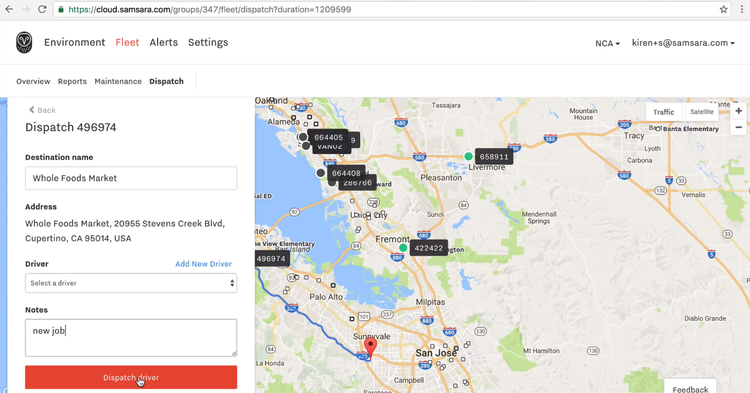
Key Features
Basic systems allow for simple asset tracking. Other features associated with fleet management solutions also include:
- Driver records. Keep records of driver information, such as insurance information and driving history. Measure driver performance to ensure work is being done on time, or analyze long-term driver behavior for signs of potential issues.
- Work orders. Maintain accurate work orders for all maintenance requests, vehicle history, and driver behavior.
- Service management. Create alerts for scheduled maintenance based on driving behavior, warranty information, and fuel usage. Maintain a historical list of maintenance performed.
- Parts inventory database. For those companies with internal maintenance management, track spare parts and materials.
- Route mapping. Customizable mapping systems can include geographic information systems (GIS) mapping and turn-by-turn instructions. A GPS fleet provides a map of all your assets in their current locations.
- Vehicle location history. Track vehicles with an animated vehicle history trail to see where the vehicle has been down to each turn, each stop, and the time at each stop. Decrease route times and hold your drivers accountable. The mapping function lets you see when your drivers drive faster than the posted speed limits.
- Route optimization. Route optimization will help you and your drivers create the best and most efficient route for better fuel management. You can also reroute drivers or technicians as needed to reduce fuel costs when idling.
- Maintenance. Whether you manage your fleet maintenance in-house or outsource to a third party, maintenance schedules can reduce downtime and keep your fleet running.
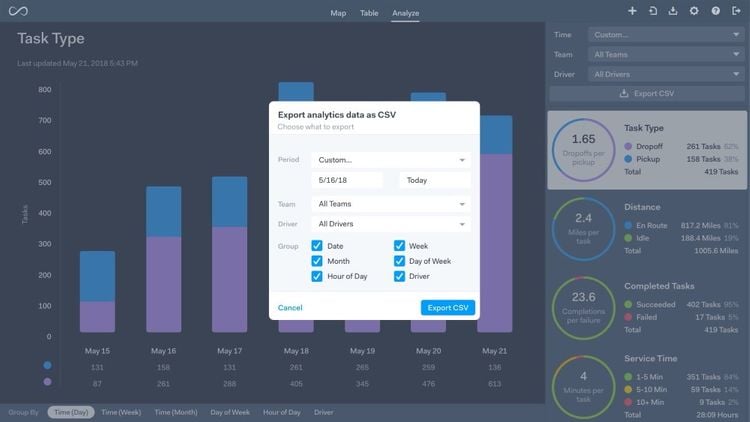
Fleet Management Software Pricing
Fleet management software costs per vehicle can range from $4 to $150/month. Typical use cases average $35 per vehicle, per month. Premium features like GPS tracking, route planning, or condition monitoring increase costs. Here’s a general breakdown of what you can expect to pay based on the size of your business.
Low-Tier
- Fleet Size: 1-10 vehicles
- Average Yearly Cost: $1,800 - $6,000 per year
- Examples: Fleetio, AUTOsist, Zubie
Mid-Tier
- Fleet Size: 10-50 vehicles
- Average Yearly Cost: $6,000 - $30,000 per year
- Examples: Samsara, Verizon Connect Reveal, GPS Insight
High-Tier
- Fleet Size: 50-200 vehicles
- Average Yearly Cost: $30,000 - $180,000 per year
- Examples: Geotab, Fleet Complete, Omnitracs
Enterprise-Tier
- Fleet Size: 200+ vehicles
- Average Yearly Cost: $180,000+ per year
- Examples: Trimble, Motive, Azuga
Fleet tracking software prices vary by product but typically depend on required features and the number of managed vehicles. These two factors can help you calculate potential costs within a reasonable budget. On-premise or cloud-based deployment can influence the total price.
In-House Vehicle Maintenance
Two main ways to handle your fleet’s vehicle maintenance are in-house or through third-party sources. Managing your fleet internally takes a lot of resources, especially when you need to remove vehicles from the fleet for repairs, schedule drivers, and plan out predictive maintenance to minimize downtime. Fortunately, fleet maintenance software can help manage staff, schedule work, order parts, and maintain records in-house.
Parts Inventory Management
Unlike a GPS vehicle, your spare parts aren’t tracked with real-time satellite coverage. However, a fleet management software solution can track the parts you need, including filters, oil, and fuel. You can also maintain an inventory of other parts that may not be used as frequently based on vehicle make, model, and year.
Coordinate Scheduling
When managing a small fleet, scheduling vehicle inspections and maintenance may not seem difficult. However, scheduling becomes more important when managing dozens or hundreds of vehicles. You need to ensure your fleet management platform can coordinate between staff on hand to complete the work and the parts available so you can get the vehicle back into service and out on the road.
Reduce Liability
Fleet managers can use GPS tracking tools to see which drivers follow assigned routes and stay within posted speed limits. These records can lower your insurance costs by providing proof of good driver behavior. Similarly, maintenance records can protect your company in the event of an accident by showing when maintenance was last performed and what parts were used.
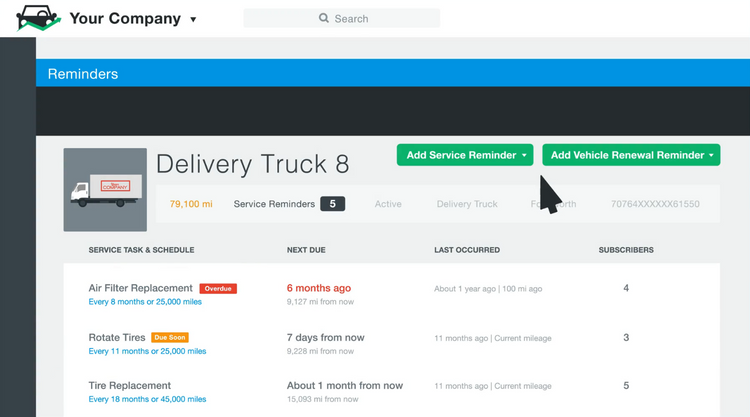
Outsourced Vehicle Maintenance
If you outsource your maintenance to a dealer or repair shop, it is still important to track the work completed. You need to keep a service history of those items and the associated cost of the repairs. Additionally, use the service history to determine when the vehicle needs to go in for scheduled maintenance.
Third-Party Fleet Services
Fleet tracking tools show real-time updates to vehicle locations and maintenance work orders, keeping your third-party partners accountable.
Out-of-State Fleet Services
Drivers can mail or scan invoices and service records into the system, where the documents can be stored with vehicles for better records management. Gather records from different repair facilities and store those records in the software. Vehicle tracking systems are particularly valuable for fleets that operate over multiple states or countries.
Best Software Options
Fleet management depends on business processes provided by software. Some systems are cloud-based for access anywhere, ideal for global corporations. Others include mobile apps for on-the-go updates.
If you are ready to find which fleet management software options are right for you, we can help. Through a brief phone call, our software specialists will look to better understand your business and software needs to help you locate a handful of solutions that can address the issues you are currently experiencing. Get started today with Software Connect.





















